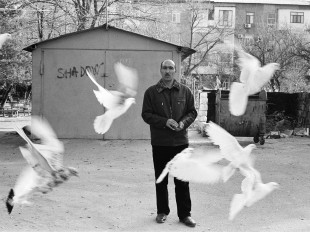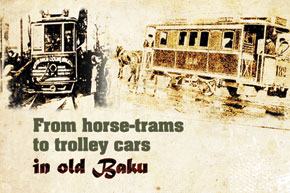 In early November 1887, Zeynalabdin Taghiyev and five other stockholders founded a joint stock company for horse-drawn trams. One report hailed the horse-drawn tram service as a true revolution in the city’s transport when it opened on 7 April 1889. The tram system was under construction, however, there were still traditional means of transport in the city: thousands of riding horses, all sorts of carts – arabas and gazalags, sulkies and hackney-cabs, the popular phaetons and the luxurious carriages of the rich. Towards the end of the 19th century there were even several automobiles on the streets of Baku.
In early November 1887, Zeynalabdin Taghiyev and five other stockholders founded a joint stock company for horse-drawn trams. One report hailed the horse-drawn tram service as a true revolution in the city’s transport when it opened on 7 April 1889. The tram system was under construction, however, there were still traditional means of transport in the city: thousands of riding horses, all sorts of carts – arabas and gazalags, sulkies and hackney-cabs, the popular phaetons and the luxurious carriages of the rich. Towards the end of the 19th century there were even several automobiles on the streets of Baku. Soon after the establishment of the Baku society for horse-drawn trams, the stockholders leased the exploitation of the routes to a rich merchant, Mustafa Rasulov. He owned several caravanserais, guest houses, hotels and a large trading company in the city. He was also well known for having rebuilt the ancient, half-ruined Qasim Bey Mosque on Quarantine Street [now Hazi Aslanov Street].
The first year the use of the tram route yielded only 52,000 roubles in income. However, between 1890 and 1895 income increased from 118,000 to 159,000 roubles a year. A steam-driven tramway started on the Black City line (from the railway station to the Nobel Brothers’ office in Black City) on 24 September 1889. It was later replaced by a horse-drawn tram in 1894. These trams continued to function in Baku until 1 October 1923.
Smoking/No smoking?
There were two types of horse-drawn trams in Baku – summer and winter. The trams were pulled along rails by two horses and a third horse would be harnessed on hills. Smoking was strictly forbidden. This is what the Baku mayor wrote to the office of the Head of Baku City Administration:
In answer to the report of the factory inspector of the 5th region of Baku Province, presented by the office of the Chief of City Administration dated 23 May, Number 10142, the Baku Board of Administration has the honour of informing them that the prohibition of smoking in the open cars of the horse-drawn trams will not only create inconvenience for the public, but might also lead to a reduction in the number of passengers. Prohibition of smoking in open cars is not practised in other cities. (State Historical Archive of the Republic of Azerbaijan (SHARA), Fund (F.) 389, Inventory (I.) 1, Dossier (D.) 268, Sheet (S.) 102).
In wintertime tram windows were shut tight. During the summer they operated without doors or windows, which sometimes led to passengers falling off! It was mandatory for the administration of the horse-drawn trams to inform the Baku Board of Administration about all technical disorders on the line or passengers falling off of the trams.
The office of the Baku city horse-rail road has the honour to forward herewith the report of conductor N 63 Veliyev about the falling of a passenger off a tram on the corner of Merkuryev [now Zarifa Aliyeva Street] and Krasnovodsk [now Samed Vurgun Street] on 6 September 1911. (same, F. 389, I. 1, D. 268, S. 136).
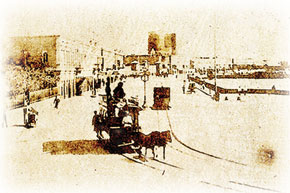 Dated 23 August 1912 N 61… regarding the halting of the horse-drawn tram on Olginsk Street [now M.E. Rasulzadeh Street]… In terms of the stated incident dated 3 August, it can solely be explained by the circumstances that the pavement on Olginsk Street is so burnished and slippery that the horses are having a hard time getting the tram moving, especially under the strain that is necessary with passengers aboard…. (ibid, F. 389, I. 1, D. 348, S. 4).
Dated 23 August 1912 N 61… regarding the halting of the horse-drawn tram on Olginsk Street [now M.E. Rasulzadeh Street]… In terms of the stated incident dated 3 August, it can solely be explained by the circumstances that the pavement on Olginsk Street is so burnished and slippery that the horses are having a hard time getting the tram moving, especially under the strain that is necessary with passengers aboard…. (ibid, F. 389, I. 1, D. 348, S. 4). One ride on a new tram cost five kopeks. It was just three kopeks on an old one, in a summer tram, or on the roof (upstairs).
…children under 5 who do not take up much space in the tram ride for free. Police officers in their uniforms in the performance of their duties may ride on all lines free of charge, according to the special procedure specified in the agreement between the administration of the horse-drawn trams and the police; there must be enough headroom for an ordinary police officer to stand up. (ibid, F. 389, I. 1, D. 186, S. 73)
Transport timetables - 1895
By 1895 horse-drawn trams were already operating on four routes, as follows:
Line 1: Station – Bayil Cape.
Telefonnaya (now 28 May Street), Morskaya (now Bulbul Ave.), Molokan (Khagani), Mariin (Rasul Rza), Baratin (academician Alizadeh), Mikhailov (Aziz Aliyev), Alexander II Quay (Neftchilar Ave.), Bayil Cape (to the former Commune of Paris factory). It returned along Alexander II Quay, Mikhailov, Merkuryev (Zarifa Aliyeva), Petrov Square (Museum Centre), Krasnovodskaya (Samed Vurgun), Birjevaya (Uzeyir Hajibeyov), Morskaya, Telefonnaya and railway station.
Line 2: Station – Shemakhinka.
Station (Pushkin), Telefonnaya, Morskaya, Molokan, Marinskaya Square, Parapet (Khagani Garden), Kolyubakin (Nigar Rafibeyli), Vorontsov (General Azizbeyov), Balakhan (Fuzuli) and Shakh (Shikahi Kurbanov). It returned along Shakh, Kubin Sqare (Fuzuli Square), Bazarnaya (Azerbaijan Ave.), Kolyubakin, Merkuryev, Petrov Square, Krasnovodskaya, Birjevaya, Morskaya, Telefonnaya and Vokzalnaya.
Line 3: Bayil Cape – Shemakhinka.
Bayil Cape to Alexander II Quay, Mikhailov, Merkuryev, Olginsk, Velikoknajeskiy Avenue, Parapet (Khagani Garden), Vorontsov, Balakhan, Kubinskaya Square and Shakh. It returned along Shakh, Kubinskaya Square, Bazarnaya, Kolyubakin, Parapet, Velikoknajeskiy Avenue, Mikhailov, Alexander II Quay and Bayil Cape.
Line 4: Station – Black City.
The city takes over
In 1910 the municipality bought out the horse-drawn tram routes in Baku.
… dated 12 January 1910, the Baku City Council hereby resolved regarding the agreement with the Society of Horse-drawn Tram Routes:
Solve the issue conclusively at present session under the following conditions:
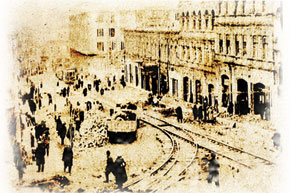 1 – The amount to be paid by the City Municipality to the Society is valid only under an amicable agreement; and is not related to lawsuit whatsoever,
1 – The amount to be paid by the City Municipality to the Society is valid only under an amicable agreement; and is not related to lawsuit whatsoever, 2 – The settled amount is not subject to change and is conclusive.
3 – The office of the Society is given to the city as a whole, according to the contract the properties sold should accord to the Society’s inventory. The final amount is set at 850,000 roubles. The Society is given until 12 March 1910 for a final answer; the lawsuit is to be continued…
6 – The employees of the Society are considered dismissed by the Society and the Society is to settle all payments with them due to handing the enterprise over to the city government.
7 – The handing over of the enterprise to the city is to start on 15 February 1910.
8 – N.A. Eyvazov, M.A. Sadikhov, M.M. Schumacher, I.B. Ashurbeyov, and A.A. Hasanov are elected to the commission which is assigned by the Council and the Board of Administration to carry out the admission of the enterprise. (ibid, F. 389, I. 1, D. 222, S. 10, 11, 13).
The city authorities immediately started reorganizing the horse-drawn trams, including their administrative structure and staffing, which caused many complaints from former employees to the city’s Board of Administration.
The Administration of the Baku City horse-drawn trams brings to the attention of the Board that, while hiring employees, the Administration was guided solely by benefit to the enterprise, thus the Administration did not hire those found unfit, by the medical commission or for other reasons, for the purposes of the enterprise; thus the administration finds the complainants’ requests to be subject to satisfaction. Chairman of the Administration. (ibid, F. 389, I. 1, D. 225, S. 16)
A three-horse hill
The new administration of the city horse-drawn tramway drafted a project to extend the line from the beginning of Bayil to the beginning of Bibi Heybat, which meant that the trams would go through Bayil as far as the beginning of the slope up to Bibi Heybat. That is where the Bayil ‘Electric Power’ station was located. In Bayil, where the tram line originally finished near the distillery built by Arthur Koppel, there was a big hill. Thus the Administration planned a line along the seashore, where they harnessed a third horse at the foot of Bayil with a gradual ascent towards the power station. The new line was of great significance for working men.
Later, they launched another, quite short, line, Station - Shemakhinka, which became quite popular. It passed along Shemakhinka, Balakhan Street, Sabunchu Station, Vokzalnaya Square and returned along the same route.
As well as extending the line, the Administration of the City horse-drawn tramway spent heavily to restore the whole station and on the financial requirements of the tramway, including purchasing more horses. A letter from the Baku City horse-drawn tramway to the Baku Board of Administration dated 15 October 1912, N 82.
…among other issues, 50-60 horses have been successfully bought. Considering the conditions explained above and the circumstances, the acquisition of horses was a very pressing and rather urgent matter. Because of the lack of horses we had to hold back the launch of the number of trams necessary to meet current demand… (ibid, F. 389, I. 1, d. 366, S. 89).
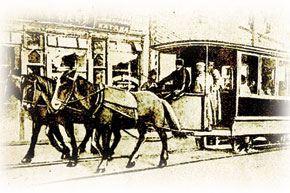 The age of electricity
The age of electricity The existing lines of the Baku horse-drawn tramway mainly served the central streets of the city. But new times were coming and in many Russian cities tramways functioned on electric power. There was a plan to build a tramway in Baku in 2 to 3 years, which meant towards 1913.
Office of the Governor of His Imperial Majesty in the Caucasus dated 25 September 1911, N 20078, about the submission of the concession to arrange and exploit an electric tramway and street lighting by the Baku City Administration to the representative of the Antwerp Bank, engineer Meus.
In the spring of 1910, the [Baku City] Council assigned the [Baku City] Board of Administration to order several projects of tramway construction along the network proposed by the Board and the financial commission of the horse-drawn tramway. This network was divided into two lines, the first being 18 versts [a Russian system of measurement, just over 1km], the second 8 versts.
The Board of Administration assigned three firms to draft projects in line with the technical conditions applied in Moscow City: the Universal Electricity Company, Westinghouse, and Siemens and Halske. The first two firms presented mature projects with calculations and drawings of the entire construction, however cost estimates were made only for the first line, whereas the third firm presented a project with only an explanatory letter, short-term cost estimates and several drawings without any technical calculations and the City Administration saw fit to return the projects due to their deficiencies.
… the proposals, after thorough consideration at the Board and city commissions, where they were changed fundamentally, amounted to the following: the tramway will be built in one line of 27 versts in a time frame of up to three years and will connect White City, Balakhani High Road, Ermenikend, Salyan Barracks, the Upland and Bayil with the city… (ibid, F. 389, I. 1, D. 281, S. 29)
However, none of these plans to build a tramway in Baku were fulfilled. Only in 1912 was tramway construction commenced in Baku.
All hands to the shovel!
In March 1923, in a hard time of breakdown and hunger, work began on a loop line of the tramway that was to connect the centre with the railway station area. Everybody, old and young, took part in building the first line. On weekends, as well as after the working day, tens of thousands of workers and clerks would join the builders. The citizens of Baku were so enthusiastic that the first tramway was finished two months ahead of time (in only eight months).
The construction in Baku was rightly considered one of the most ambitious, not only in the Caucasus region but also in the entire USSR. Here are some quotes from the newspapers of the time:
‘Petrograd sends high-voltage wires’; ‘Moscow reports that they are concluding construction of tramway carriages in the Mitishinsk and Kolomensk Factories’; ‘People of Kharkov pledge to complete the engine ahead of time’; ‘Donbass specialists decide to complete the order for rails quickly…’
A city celebrates…. the tram
And finally the long-awaited day arrived: 8 February 1924.
The honour of driving the first ever carriage on the streets of Baku fell to veteran coachman of the horse-drawn tramway and active participant in the construction, Alexander Lisovskiy. He recalled:
For the first couple of hours we carried the passengers free of charge. It was a real holiday, a truly great holiday for the entire nation.
It makes one ponder how great a step it was from the old tram line, harnessed to a sleepy horse, to the first-ever electric tramway in our country. While in 1920 the horse-drawn trams transported 9.9 million passengers, by 1925-1926 the Baku tramway was carrying 50 million passengers!
Sources
State Historical Archive of the Republic of Azerbaijan (SHARA),
F. 389, I. 1, D. 63, 281, 379, 384, 404, 504
F. 389, I. 3, D. 46, 49, 186, 222, 225, 229, 268, 340, 345, 348, 354, 366, 394, 395, 3397, 450, 461, 466, 484, 491, 505, 513, 538, 539, 541, 562, 567, 572, 577, 588, 589, 590, 595, 675, 728, 732, 760, 780, 787, 868, 885, 881, 887, 912, 957, 1123.
F. 50, I. 1, D. 162, 349, 430, 444, 474, 488, 552, 555, 592.


